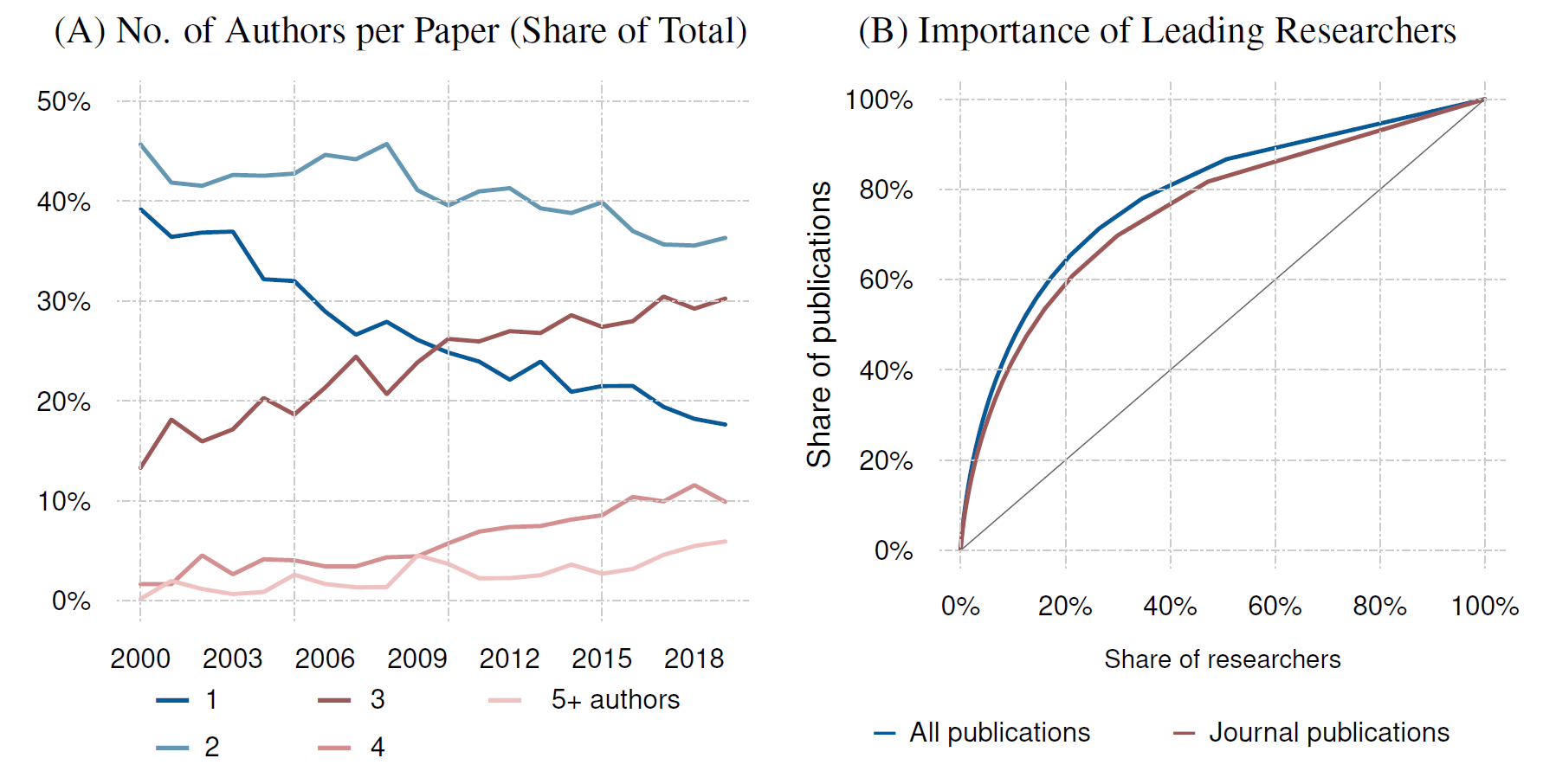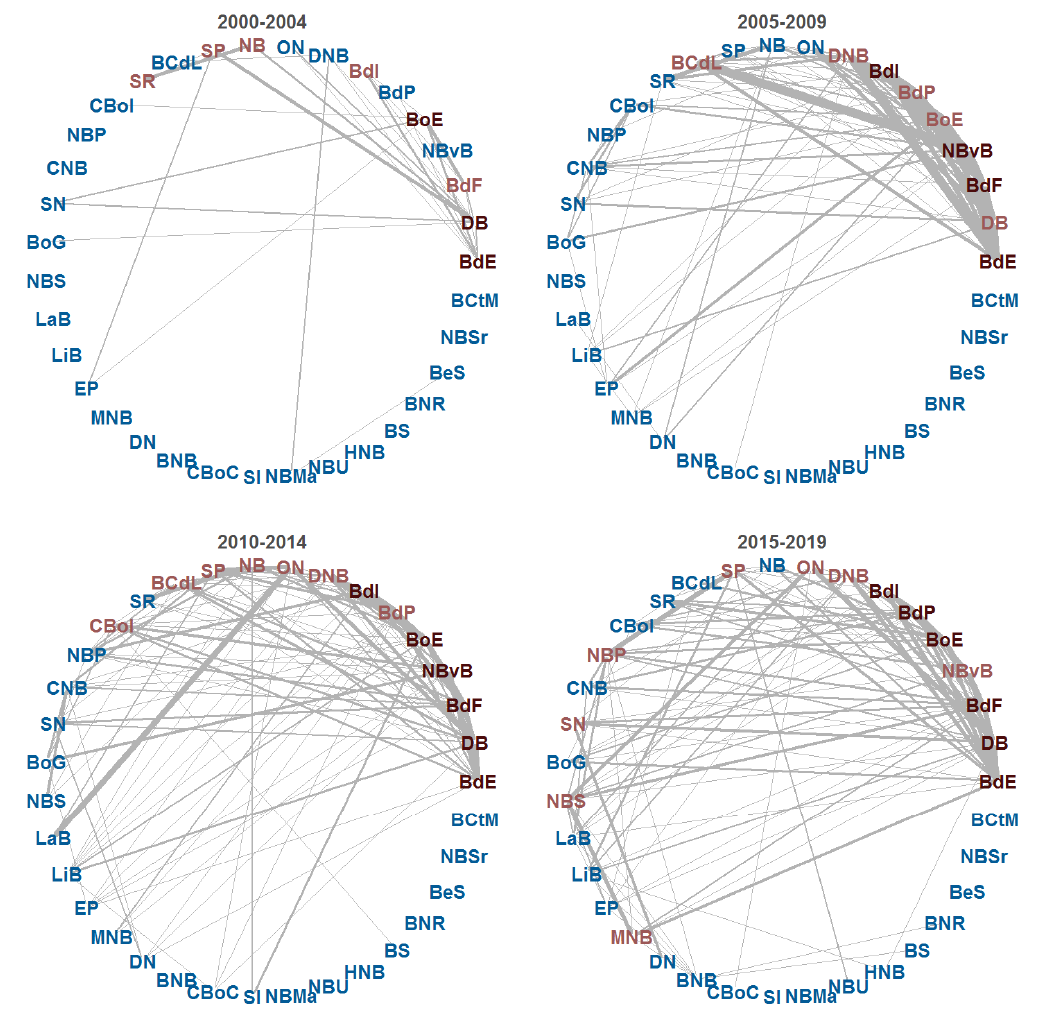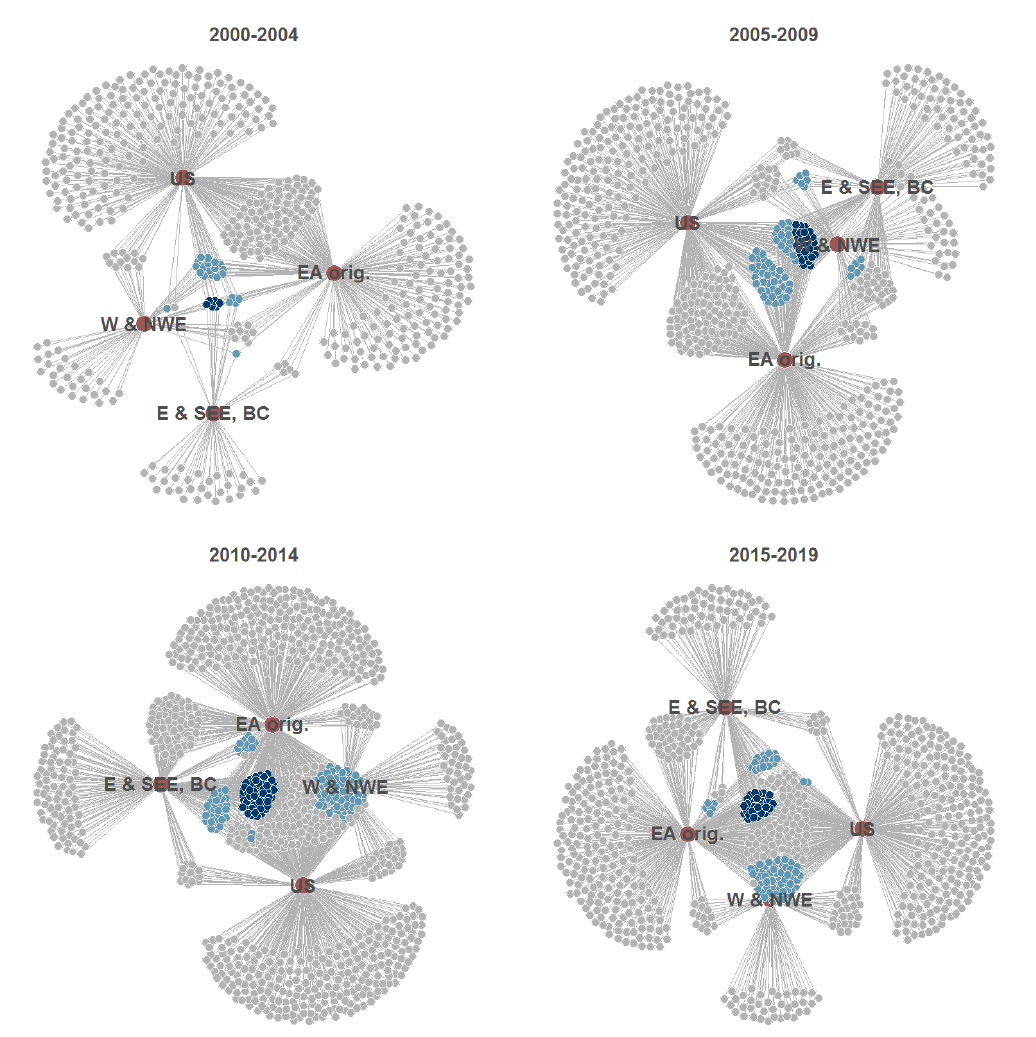How do central banks collaborate in the field of research?
Central banks form a dense and constantly growing network of co-authorship links between their researchers and analysts. This may to a large extent reflect the increasing amount and scope of central banks’ duties and the growing interconnectedness of world economies and financial systems. In our previous blog article, we focused on the significant differences and similarities between various aspects of the research conducted in central banks. For this purpose, we constructed a unique data set containing information about more than 20,000 research papers published by 50 central banks in Europe and the US over the last two decades. We used the same data set to look in more detail at cooperation between central banks and with universities and other research institutions. Most of these links are region-specific, meaning that a central bank is more likely to collaborate with a university or other research institution from its own country or region. Further, it suggests that researchers tend to leave national central banks to relocate to supranational institutions, such as the European Central Bank (ECB) and the Bank for International Settlements (BIS), or to academia.
Published in the CNB Research and Policy Notes No. 3/2020
Collaboration among economists in the field of research is increasing constantly over time. The average size of research teams is growing, as is the proportion of papers with multiple co-authors. These trends are well documented in academic research, but less so in central banking and supranational institutions. The pioneering study in this regard is an IMF paper examining the IMF’s working papers and the co-authorship network they form. Among other things, it confirms the trend of constantly growing collaboration. The common links between researchers generate positive knowledge spillovers not only directly between the collaborative authors, but also indirectly to other researchers, who may be connected within complex research networks. Closer cooperation is also good for individual productivity. In our paper, which we summarise in this blog article, we examine the size and structure of research teams, the density of co-authorship networks and the mobility of researchers between institutions.
Cooperation between researchers in central banks is growing
The average number of authors per publication has increased significantly over the last two decades (Figure 1, panel A). The share of publications with three authors has grown the most, while that of research papers with four or more authors has increased to a lesser extent. By contrast, research teams composed of just two authors or a single author are becoming less and less common. Although the size of research teams is increasing, only a relatively small proportion of authors contribute substantially to the total number of research papers completed (Figure 1, panel B). Specifically, approximately 10% of authors have contributed to about 50% of all 20,000 research papers published since the year 2000 and listed in the IDEAS/RePEc database. Central banks may thus be prone to the “extinction effect” that has been found to be present in academic research. The departure of top researchers may result in a decrease in the quality and quantity of research produced by a central bank.
Figure 1 Collaboration between researchers in central banks

Central banks in Europe started to collaborate more on research after the Global Financial Crisis
The density of the network of co-authorship connections between the US Federal Reserve Banks has not changed significantly over time and remains high. By contrast, collaboration between central banks in Europe has grown considerably (Figure 2). In the period before 2004, just three central banks accounted for 50% of all research publications. In 2009 the figure was four banks, with some formerly isolated central banks from Central and Eastern Europe having become involved in collaborations. However, it was not until after 2009 that the mutual links increased to a greater extent. This increase may have reflected several factors combined. First, the expansions of the EU in 2004, 2007 and 2013 fostered an increase in cooperation and knowledge sharing. Second, collaboration within the European System of Central Banks intensified in many newly established research and working groups. The ECB was often the lead coordinator in this regard. Third, the Global Financial Crisis of 2008–2009 revealed a dark side of highly connected financial markets, possibly motivating researchers from various fields and regions to collaborate more closely.
Figure 2 Collaboration between central banks in Europe

Note: Each edge between two central banks (nodes) represents the relationship between the central bank where the paper was published and the affiliation of the authors. The width of the edges does not reflect the number of papers but rather the total number of such relationships and hence the intensity of collaboration. The colour of the nodes indicates the relationship to the number of papers. Central banks shown in red accounted for 80% of all publications (dark red for 50% and light red for the additional 30%).
Collaboration between central banks, universities and other research institutions is also increasing
The US Federal Reserve Banks and the central banks in Europe maintain very fruitful collaborations with other research institutions (Figure 3). Most of the common links are region-specific, meaning that central banks collaborate more often with universities and other institutions in their own countries or regions. Looking at this from the perspective of universities and other research institutions, only a relatively small proportion of them collaborate with central banks in all four regions (in dark blue) or in three out of the four regions (in light blue). The most significant of them are the Centre for Economic Policy Research (CEPR), the National Bureau of Economic Research (NBER) and the Institute of Labor Economics (ILE). Surprisingly, the increased collaboration seen over the last decade has not been reflected in the share of research papers published in academic journals. This share has long stood at around 40% (if we abstract from publishing delay in 2018 and 2019).
Figure 3 Collaboration between central banks, universities and other research institutions

Mobility and churn of researchers
To find out something about the mobility and churn of researchers between central banks, we have to look at co-authorship links from a rather different angle. In the above figures, the relationship is always formed between the central bank where the paper was published and the affiliation of the authors. While the authors’ affiliation represents a current view, their relation to the central bank is a historical record. This is because the authors’ affiliation can change over time and may have been different at the time of publication. The central bank, however, does not change. If we form links solely on the basis of the authors’ affiliations (and hence leave the central bank out of the relationship), we can find out a great deal about relocations of authors between institutions over time. It can be assumed that at least one of the authors of a research paper was working in the central bank at the time of publication. So, if none of the authors is currently affiliated with the central bank where the paper was published, there has probably been some mobility. Because this provides only an indirect indication, we cannot look at the individual relationships, but we can look for changes in the distribution between regions. We did indeed identify such changes (Table 1). So, when we look solely at the relationships between authors based on their affiliations, the share of co-authorship relationships increases substantially in the two supranational institutions (the ECB and the BIS) and in relation to universities and other research institutions. The share of collaboration between national central banks from European regions meanwhile falls. This suggests that researchers and other economists tend to leave national central banks to relocate to supranational institutions and academia, which might potentially have negative consequences associated with human capital flight.
Table 1 Co-authorship relationships from two different perspectives
| Author–central bank relationship | Author–author relationship | |
| ECB&BIS vs. ECB&BIS | 15.7% | 33.8% |
| ECB&BIS vs. national central banks (NCBs) | 12.1% | 10.9% |
| NCBs vs. NCBs | 48.8% | 12.6% |
| NCBs vs. other research institutions | 17.4% | 29.2% |
| ECB&BIS vs. other research institutions | 5.9% | 13.5% |